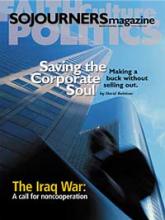Walking around my hometown of San Francisco, I am always struck by a remarkable cultural vibrancy that translates into religious dynamism. In Chinatown, the Gold Mountain Monastery serves vegetarian meals daily, Chinese-speaking nuns minister to both longtime residents and recent arrivals, and people escape bustling streets to worship in the peaceful temple. In the Mission District, a predominantly Latino area of the city, St. Peter's Catholic Church houses a refugee center, health services, a homeless shelter, and legal services for immigrants and offers Mass in Spanish. Templo de la Fe, a storefront charismatic church, works with youth trying to leave the gangs that congregate on the streets of the Mission District. Mosques, Hindu temples, Buddhist monasteries, Vietnamese Catholic churches, Santeria stores, Sikh gudwaras, Russian Orthodox spires, and storefront churches all shape the landscape of my town.
According to Harvard religion scholar Diana L. Eck, the United States—which has more American Muslims than Episcopalians—is the most religiously diverse nation in the world. This is mainly due to the largest wave of migration in U.S. history, which is having a profound impact on the ethnic and racial composition of the country. Since the early 1990s, almost a million legal immigrants have entered the United States each year, including perhaps 150,000 undocumented persons. These new migrants are racially, ethnically, and religiously more diverse than earlier groups. In 1960, seven of the top-10 sending countries were European; by 1996, six of the top 10 were Asian, one of them was Mexico, and only one of them was European.
Read the Full Article

